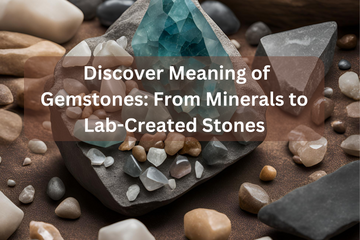The Fascinating World of Gemstones: A Deep Dive into Minerals, Rocks, Organic Materials, and Lab-Created Stones
Ever wondered what sets one gemstone apart from another? Let’s dive into the fascinating world of stones and uncover their unique stories!
Many people are drawn to gemstones, often choosing them based on what they've read or heard about their healing powers or aesthetic appeal. However, there's more to these precious stones than meets the eye. While gemstones are beautiful, they differ significantly in composition, origins, and the properties they offer. Many buyers may not fully understand what they're purchasing. That’s why we’ve crafted a short guide to help you navigate the world of gemstones, shedding light on their unique stories. Using credible sources and expert insights, we’ll take you on a journey through the fascinating tales of minerals, rocks, organic materials, and even lab-created stones, so you can make informed decisions when selecting the perfect gemstone for yourself or as a gift.
Let's begin by understanding the different categories of stones. Stones can be broadly classified into four main categories based on their composition and origin. These are:
-
Minerals: Naturally occurring, inorganic substances with a definite chemical composition and crystalline structure. They are the building blocks of many gemstones. Examples include quartz, beryl, and garnet.
-
Rocks: Aggregates of one or more minerals, sometimes combined with mineraloids. These stones are often used for ornamental purposes. Lapis lazuli and obsidian are well-known examples of rock-based gemstones.
-
Organic Materials: These are gemstones derived from living organisms, including plants and animals. Amber, pearls, and coral fall into this category.
-
Artificial/Lab-Created Stones: These are man-made gemstones that mimic the appearance and properties of natural stones. Examples include lab-created diamonds and cubic zirconia.
Each category brings its own unique qualities, and understanding these differences can help you choose the right stone for your needs or preferences. Let’s explore these categories in more detail!
Minerals: Nature’s Own Gemstones
Minerals are naturally occurring, inorganic substances with specific chemical compositions and crystalline structures. These stones form deep within the earth’s crust over millions of years, and each one is unique in its color, texture, and appearance. Let’s take a closer look at some of the most beloved mineral gemstones.
Quartz Group:
The Quartz family is one of the largest and most varied in terms of gemstones. These stones come in many different colors, from the delicate pink of rose quartz to the deep purple of amethyst. Whether you're looking for a gemstone that promotes healing, like amethyst, or one that exudes warmth, like citrine, the Quartz family offers something for every taste.
-
Amethyst is well-known for its calming properties, often used in meditation to aid in relaxation and spiritual growth.
-
Citrine is a stone of abundance, believed to bring wealth and prosperity into the life of its owner.
-
Rose Quartz is often referred to as the "stone of love," promoting emotional healing and fostering a sense of peace.
Feldspar Group:
Feldspar is another important mineral group, home to some stunning gemstones.
-
Moonstone has a unique, ethereal glow that many people associate with feminine energy and intuition.
-
Labradorite is a mystical stone that flashes with different colors when viewed from various angles.
-
Sunstone is said to carry the energy of the sun, boosting vitality and positive energy.
Beryl Group:
This group includes some of the most valuable and striking gemstones.
-
Emerald is known for its deep green hue and is considered the gemstone of rebirth and renewal.
-
Aquamarine offers a refreshing, ocean-like color that brings tranquility and clarity.
-
Morganite is a peach-pink gemstone associated with unconditional love and compassion.
Corundum:
The Corundum group brings us two of the most coveted gemstones in the world: ruby and sapphire.
-
Ruby is known for its deep red color and is often associated with passion, courage, and vitality.
-
Sapphire is famous for its deep blue hue but also comes in a variety of colors, each symbolizing different attributes, like wisdom and protection.
Olivine:
Peridot, the gem form of olivine, is a striking green gemstone known for its connection to healing and prosperity.
Spinel:
Often mistaken for ruby, spinel comes in a wide range of colors, from vivid reds to vibrant pinks.
Rocks: Aggregates of Nature
While minerals are pure substances, rocks are made up of aggregates of minerals or mineraloids. These stones can have unique appearances due to their composition and are also used in jewelry and decoration.
-
Lapis Lazuli is a stunning blue metamorphic rock that has been used as a semi-precious gemstone for thousands of years.
-
Obsidian is volcanic glass that creates a smooth, reflective surface. Its deep black color has a mystical and protective association in various cultures.
-
Unakite is a granite that combines green epidote and pink orthoclase, often seen as a stone of spiritual growth.
Organic Materials: Nature’s Living Gemstones
Some gemstones are organic, derived from living organisms. These stones hold a special place in our hearts because they embody life and transformation.
-
Amber, a fossilized tree resin, is not only beautiful but often contains ancient insects and plant material, making it a tiny snapshot of the past.
-
Pearl, formed inside a mollusk, is known for its lustrous, smooth finish and symbolizes purity and wisdom.
-
Coral, formed by marine organisms, is cherished for its bright red and orange colors, often used to make jewelry.
-
Jet, a form of lignite coal, is another organic gemstone that is often used for its striking black color and light weight.
Artificial and Lab-Created Stones: The Future of Gemstones
In the modern world, advancements in technology have allowed us to create synthetic gemstones that mimic the properties of natural stones. While some purists argue that lab-created stones lack the "soul" of natural stones, others appreciate them for their accessibility and ethical sourcing.
-
Lab-Created Diamonds are chemically identical to natural diamonds but are created in controlled environments, reducing environmental impact.
-
Cubic Zirconia offers a brilliant, diamond-like shine at a fraction of the cost.
-
Synthetic Corundum, such as lab-created rubies and sapphires, has all the beauty and durability of its natural counterparts but is more affordable.
The Connection Between Gemstones and Wellness
Just as certain fragrances from our eco-friendly candles, like lavender candles for relaxation or energizing citrus candles, promote emotional and physical wellness, gemstones are often believed to have healing properties. People around the world use stones like amethyst and rose quartz in meditation or as part of their manifestation practices.
For instance, manifestation candles with crystals can be a powerful tool in helping focus your energy and intention. You might pair your manifestation candle with a gemstone that aligns with your goals—such as rose quartz for love or citrine for abundance.
Final Thoughts
Exploring the world of gemstones is like opening a treasure chest filled with unique stories, spiritual significance, and stunning beauty. Whether you're attracted to the rich history of minerals, the organic nature of pearls and amber, or the innovation of lab-created stones, there’s something about each type of stone that speaks to a deeper part of us.
At Jade's Essence, we understand the power of energy and intention, which is why we create eco-friendly scented candles with natural ingredients that help elevate your space and your spirit. Whether you’re seeking a lavender candle for relaxation or a manifestation candle with crystals, we have something to complement every aspect of your journey.
Ready to enhance your environment with the energy of gemstones? Explore our collection of hand-poured soy candles today and let the power of nature’s best work for you.
PS: Jade's Essence is the First Eco-Friendly Eco-Conscious Scented Candle Brand Blending Luxury with Sustainability.

